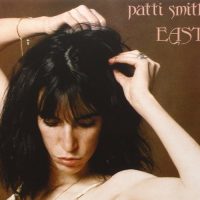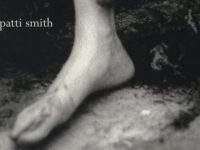“The most disappointing album of the year.” – Charles Shaar Murray (New Musical Express) on Radio Ethiopia
“Everybody thought we sold out.” – Patti Smith
One of the great truisms of popular music is that an artist has a lifetime to make his or her first album, but only six months to make the second. Sure, it’s an exaggeration, but it seems to be particularly accurate in cases where that first album is perceived to have great artistic merit, popular appeal, or commercial success.
As it is in many professions, the pressure to make lightning strike twice is great and the results are not always successful. In the music business this sophomore slump and its associated aura of deflated expectation and general dismissal crosses genres and generations, and is common enough to easily recognize.
A good example of an album that suffered such a fate is Radio Ethiopia, the 1976 release by the Patti Smith Group. It had the bad luck to be the follow-up to an album which is widely considered by music critics and publications to be one of the greatest albums ever made: Horses, Patti Smith’s 1975 debut.
From the iconic picture of the artist that graces the sleeve to the music and poetry contained within, Horses consistently gets critical praise, and has even been preserved in the National Recording Registry of the Library of Congress for being “culturally, historically, [and] aesthetically significant.” It even made the Top 50 album charts without the benefit of a major hit single to boost it.
But its follow up, Radio Ethiopia, is often criticized as having various flaws. Some contemporary reviews focused on the simple-to-the-point-of-amateur musicianship, while others said it was too wild and experimental. Still others thought that replacing John Cale with Jack Douglas as a producer was a move away from artistic integrity towards commercialism, as Douglas was at the time known best for his successful production work with successful mainstream rockers Aerosmith. Despite the expertise of Douglas, Clive Davis — the president of the Arista record company — was of the opinion the album lacked commercial potential. (Radio Ethiopia peaked on the charts at No. 122.) Even the cover photo has been called “unmemorable.”
Then Patti Smith fell off the stage during the tour to support the album, forcing her to take some time to recuperate. She didn’t release anything until 1978’s Easter, which contained her Top 40 single “Because the Night.” A hit single can forgive a lot of sins; better yet, it can even forget a lot of bad press. All was forgiven, and Radio Ethiopia got relegated to some lonely place sandwiched between two career highlights.
In retrospect, it seems that most critics missed the opportunity to make an interesting connection regarding the first and second album. It’s a connection that should have been obvious, but only rock writer/sometime lyricist Richard Meltzer ever got close, and only he knows for sure whether he truly missed the point or just chose not to pursue it.
His review from the January 1977 issue of Creem reads in part: “… you can’t do ‘Goin’ Home’-‘Sister Ray’-‘The End’ forever cause after a while it just kinda bristles with more than a morsel of, uh, datedness per se. Less Velvets in evidence than last time tho …” Yes, that Velvet Underground — the one that bassist/violaist/vocalist/songwriter and future Patti Smith producer John Cale co-founded. Also mentioned: that “Sister Ray,” from the Velvets’ second album, White Light/White Heat. The connection is there, for those who care to make the jump: Radio Ethiopia is to Horses what the Velvet Underground’s White Light/White Heat is to their debut The Velvet Underground and Nico.
Both VUAN and Horses are considered to be ground-breaking artist triumphs in popular music written largely by literary and educated artists, and both were credited to producers whose contribution to the artistic process is often regarded to be more valuable than any particular technical or musical contributions they made (Cale for Horses and New York artist Andy Warhol for The Velvet Underground and Nico). Even the outer jackets look similar, both being predominantly white in color.
White Light/White Heat and Radio Ethiopia, on the other hand fared worse in the marketplace and were considered to be noisy and experimental, mostly because they both had long, improvisational pieces closing out side two. (“Sister Ray” and “Radio Ethiopia/Abyssinia,” for those keeping score.) And, of course, both covers were predominantly colored black.
There is even a parallel to be seen in something that should be as simple as the band credits. Model, actress and Warhol associate Nico, who somehow got added into the stage show, also got her name tagged onto the band’s name — making it The Velvet Underground and Nico. And how did it happen that Andy Warhol’s name was the only one on the original front cover, appearing under his famous banana sticker art? After jettisoning Nico and Warhol, the band stripped the name back to the Velvet Underground, reflecting a return to the group’s essence. Conversely, Horses is credited to Patti Smith, but Radio Ethiopia is credited to the Patti Smith Group — again reflecting a band effort, not just that of a poet/writer working in a different discipline.
Consciously or not, Smith’s pair of releases reflects the Velvet Underground’s first two albums. Basically, each artist made a perfect pair of Apollonian/Dionysian statements, built to chase each other in a circular yin/yang dichotomy (at 33 RPM no doubt). The big difference is that over time, White Light/White Heat has become recognized as an important and influential album as well, while Radio Ethiopia continues to languish in the critical wasteland.
Perhaps the problem is the “us vs. them” stance of the original hard liners in the punk scene, a stance which solidified into the dogma that art and commerce don’t mix. Of course then, to use a producer with a proven commercial track record must logically result in some diminishment of artistic value. Yes, Douglas produced and engineered many major league successful rock albums, but his production style was not to impose his vision on the artists; instead, he was usually successful in capturing their essential identity in the studio.
Radio Ethiopia, Aerosmith’s Rocks (1976) and Cheap Trick’s eponymous debut (1977) were produced by Douglas within months of each other, yet they all sound different. (They do, however, look alike: oddly enough, like the other two albums, even Cheap Trick sports a predominantly black album cover.) But many reviews of Radio Ethiopia in the press downplayed Jack Douglas’ work and contained variations of comments like “limitations of the [hard rock mainstream] genre” and “journeyman rock.”
However, listening to the album shows it not to be the pedestrian exercise its detractors claim it is. Let it be said, though: it is a rock ‘n’ roll album, rather than the combination spoken word mixed with song affair that Horses in fact really is. As well, compared to that album, Radio Ethiopia really does sound like something performed by a band rather than by a solo act with a supporting cast.
The first side and the start of the second run the range of straight ahead rock to the pseudo reggae en vogue at the time, to melodic songs with a tough backbeat. Good, solid rock ‘n’ roll. But the final “Radio Ethiopia/Abyssinia” extended freak out echoes the aforementioned “Sister Ray” as well as the Doors’ epic “The End.” It also attempts to channel the sonic power of any number of John Coltrane’s extended jazz pieces, and perhaps even the Stooges’ cacophonous closer “L.A. Blues” from their 1970 release Funhouse. (Incidentally, that’s yet another album made by a band after a John Cale produced debut.)
Many fans and critics found it hard to understand, and this seemed to set the tone for subsequent criticism of the album as a whole.
Still, it’s hard to see how an album can be “too commercial” and “too unlistenable” at the same time. It’s like the alternative rock scene didn’t get what they wanted (which was Horses, Part II) and it was easier to dismiss the record than to deal with it. The real kicker is of course that Patti Smith’s next album, Easter, was clean, professional and showed what the group could do if they really wanted to take a run at the charts.
Maybe it just goes to prove that in the end, radio play is an easier concept to come to terms with than Radio Ethiopia.
- How David Bowie’s ‘The Next Day’ Stripped Away All of the Artifice - March 15, 2023
- Why Deep Purple’s ‘Who Do We Think We Are?’ Deserves Another Listen - January 11, 2023
- In Defense of the Often-Overlooked Mott the Hoople - November 10, 2022




